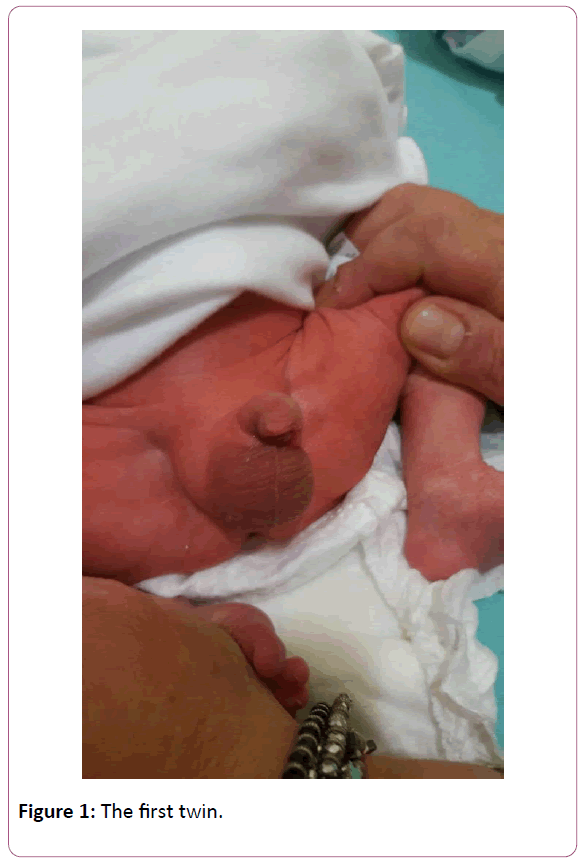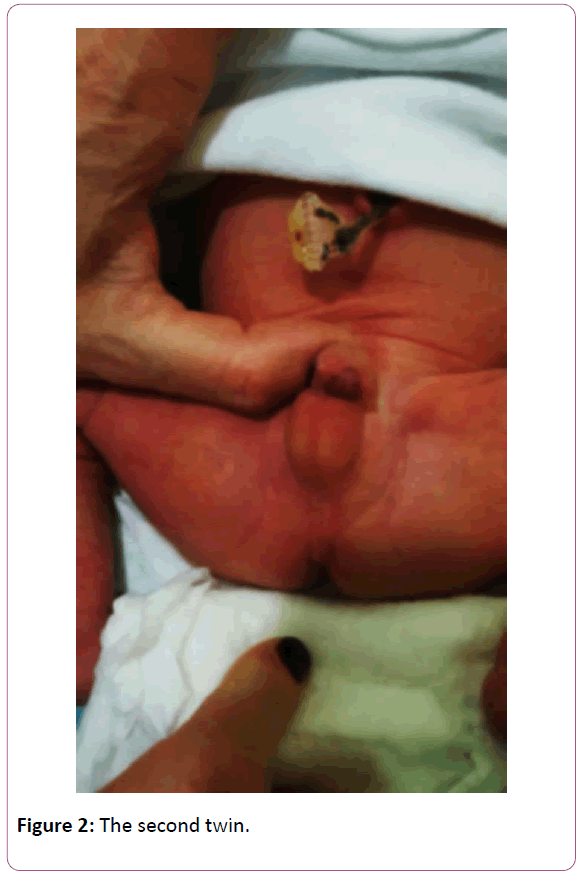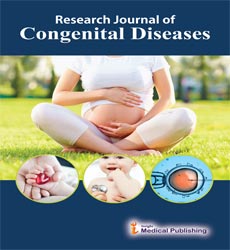Hypospadias and Associate Malformations in Twins: A Clinical Case
1UOC Neonatology and Outpatient Pediatrics, Putignano Hospital, Italy
2Specific Training Course in General Medicine, Italy
3UOC Obstetrics and Gynecology, Putignano Hospital, Italy
4Department of Emergency and Organ Transplantation, Hospital Consortium Policlinico of Bari, Italy
- *Corresponding Author:
- Tripaldi Clelia
UOC Neonatology and Outpatient Pediatrics
Putignano Hospital, Italy
Tel: 0551-62922114
E-mail: clelia.tripaldi@libero.it
Received date: January 19, 2018; Accepted date: February 05, 2018; Published date: February 15, 2018
Citation: Clelia T, Stefania M, Rosa S, Franca LA, Silvano P (2018) Hypospadias and Associate Malformations in Twins: A Clinical Case. Res J Congenit Disease Vol. 1 No. 1:5.
Copyright: © 2018 Clelia T, et al. This is an open-access article distributed under the terms of the Creative Commons Attribution License, which permits unrestricted use, distribution, and reproduction in any medium, provided the original author and source are credited.
Abstract
In twin pregnancies the incidence of congenital abnormalities is greater than in singleton ones. This is true especially in monozygotic ones. The higher incidence of hypospadias in monochorionic twins has already been described and so also the association between hypospadias and heart anomalies. We examined the case of a couple of twins both affected by hypospadias, whose clinical history represents an example of association between minimal anomalies of cardiovascular system and hypospadias in twins. The first fetus had first degree hypospadias and unique umbilical artery. The second fetus presented first degree hypospadias and bilateral cryptorchidism. In the first twin, who featured bilateral cryptorchidism, echocardiogram was normal. In the second baby echocardiogram had been diagnosed oval forame patency. The uniqueness of the clinical case we reported is due to the association of a concordant urogenital malformation (phenotypically identical first degree hypospadias) with an anomaly of cardiovascular apparatus, different in the two infants (single umbilical artery in a twin and oval forame patency in the other), in two dichorionic twins.
Keywords
Pregnancies; Clinical case; Hypospadias; Twins
Introduction
It has long been shown that in twin pregnancies the incidence of congenital abnormalities is greater than in singleton ones. This is particularly the case for monozygotic twins, as in the dizygotic this incidence does not differ significantly from the single births [1]. The malformative pathology that can be observed in multiple pregnant women is very heterogeneous, both in clinical and eziopathogenetic terms, including similar conditions to single and other typical of multiple pregnancies.
In some cases, the twins have the same malformation and are therefore defined as concordant; they are discordant when one only has morphogenetic defects or both have congenital abnormalities, which are distinguishable, however, from the clinical and embryological point of view [2]. The rate of concordance varies widely in relation to the type of twin pregnancy and the etiopathogenesis of the defect.
Monozygotic twins are gender-compatible and phenotypic, but full 100% concordance can only be theoretical in relation to possible genotypic differences or the role of environmental factors in different modes and at different moments. The prototype of phenotypic discordance for malformations between monozygotic twins is represented by vascular disruption that results in absolute discordance for phenotypic and prognosis characteristics [3,4]. In recent years, thanks to the records for congenital malformations, it has been possible to document an increased risk of malformations in the in-vitro fertilization techniques. This increase is extreme in the different cases and according to the type of anomaly considered. Numerous factors seem to contribute, both intrinsic to the couple with hypofertility and related to the medically assisted procreation method used. In particular, with the increasing spread of intracytoplasmic sperm injection, a significant role has been attributed to the absence of natural selection of male gamete. More recently, the possibility that the manipulation and conservation of gametes and embryos, which occurs with assisted procreation, interferes with essential epigenetic mechanisms for early stages of the replanting stage and for the proper development of the embryo and fetus [5]. The conservation and culturing conditions of gametes and embryos may result in modification of DNA methylation and chromatin structure, thereby increasing the risk of pathologies due to altered expression of imprinted genes.
The clinical history we describe represents a synthesis of all possible malformative problems associated with hypospadias in twins. Anomalies most commonly associated with hypospadias in bicorial twins, in 10% of the cases are urogenital tract pathologies (unilateral renal agenesis, bladder-ureter reflux, pyelo-ureteral joint stenosis, megaureters) [6]. Malformations of the urogenital apparatus, in a variable percentage of non-syndromic cases, are associated with malformations of the cardiovascular and musculoskeletal system.
Hypospadias is a congenital malformation with multifactorial etiology, whose incidence has increased considerably in recent years. It represents a defect in the virilization of external genitalia in the embryo, and as such may have several manifestations ranging from major anatomical alterations to minimal abnormalities such as the foreskin sketch. The key element in its genesis consists in stopping the closure of the urethral shower, resulting in incomplete formation of the urethra. This central anomaly is associated with alterations of the other constituent elements of the penis, such as buck band development, dartos, and cute of ventral penis [7]. There are various levels of hypospadias, which in the most serious forms can lead to erroneous gender attribution if they are not properly evaluated. Malformation affects 1 out of 300 males born alive. There is no mendelian transmission of this defect. The family trend has hypothesized through retrospective studies a model of autosomal multifactorial inheritance with varying penetration, so for every affected child there is 20% of the chance of having another affected first degree family. Frequent is the association with other urogenital pathologies, which are present in about 3-15% of cases.
Clinical Case
We describe the case of a pair of twins affected by hypospadias admitted to our neonatal nursery. The twins we described were born from mother at first pregnancy, with caesarean section at the end of the 36th week of gestation. The pregnancy was spontaneous, bicameral, with negative maternal infection history. The ultrasound determination of sex during 20- week ultrasound was remarkably difficult in both twins [8]. The first fetus, with adequate weight for the gestational age, feet presentation, had a unique umbilical artery and first degree hypospadias (Figure 1). The second fetus, small for gestational age, cephalic presentation, presented first degree hypospadias and bilateral cryptorchidism (Figure 2). For the presence of hypospadias and other associated malformations (single umbilical artery in the first twin and cryptorchidism in the second), both infants were submitted to diagnostic examinations such as urinary ultrasound, brain ultrasound and echocardiogram during the first week of life. In the first twin, which had a unique umbilical artery, brain, heart and urinary ultrasound had been found in the standard. In the second twin, which featured bilateral cryptorchidism, ultrasound of the brain, and urinary tract were normal, while echocardiogram had been diagnosed with oval forame patency.
Discussion
The possible inheritance at the base of the association between cryptorchidism and hypospadias in patients with both pathologies had already been reported by examining twin populations, but without a definite conclusion. Of all the congenital anomalies associated with hypospadias in twins, those of the urogenital apparatus are undoubtedly the most common, along with those of the cardiovascular apparatus. Several studies have reported the association of hypospadias, premature births and low birth weight, all of these phenomena as an expression of reduced androgenic recruitment [9]. According to the coorte study published by Schnack in 2008, the risk of family recurrence of hypospadias among twin brothers would be 50.8%, and would gradually decrease in the first, second and third degree relatives. In this study, however, the risk of recurrence was not related to the chorionicity. Instead, according to the Visser study of 2015, the incidence of hypospadias in monochorionic twins would be four times greater than in dichorionic. The association of hypospadias with malformations of the cardiovascular apparatus has already been described in monochorionic twins, particularly aortic coarctation. The prevalence of the single umbilical artery in twins is approximately three times higher than single pregnancies. The uniqueness of the clinical case we reported is due to the association of a phenotypically identical urogenital malformation (first degree hypospadias) in combination with an anomaly of cardiovascular apparatus, different in the two infants (single umbilical artery in a twin and oval forame patency in the other), in two non-monochorionic twins [10]. Therefore, the first twin, weight-appropriate for the gestational age, with hypospadias and unique umbilical artery had a double risk factor for the hypospadias itself, familiarity and unique umbilical artery. The anatomy of the penile lesion (first degree hypospadias) was absolutely identical in the two babies, although they were bichorionic and biamniotic. Unfortunately, no genetic investigation has been carried out in this case.
References
- Corsello G, Giuffrè M, Piccione M (2013) Newborn with multiple congenital anomalies: diagnostic classification and nosology. The Doctor and the Child 43: 149-157.
- Klatt J, Kuhn A, Baumann M, Raio L (2012) Single umbilical artery in twin pregnancies. Ultrasound Obstet Gynecol 39: 505-509
- Hsieh MH, Alonzo DG, Gonzales ET, Jones EA, Cisek LJ (2011) Ex-premature infant boys with hypospadias are similar in size to age-matched, ex-premature infant boys without hypospadias. Journal of Pediatric Urology 7: 543-547.
- Beleza-Meireles A, Lundberg F, Lagerstedt K, Zhou X, Omrani D, et al. (2007) FGFR2, FGF8, FGF10 and BMP7 as candidate genes forhypospadias. Eur J Hum Genet 15: 405-410.
- Schnack TH, Poulsen G, Myrup C, WohlfahrtJ, MelbyeM (2010) Familial coaggregation of cryptorchidism and hypospadias. Epidemiology 21: 109-113.
- Visser R, Burger NC, van Zwet EW, Hilhorst-Hofstee Y, Haak MC, et al. (2015) Higher incidence of hypospadias in monochorionic twins. Twin Research and Human Genetics 18: 591-594.
- Ramos-Arroyo MA (1991) Birth defects in twins: study in a Spanish population. Acta Genet Med Gemellol(Roma) 40: 337-344.
- Van Nesselrooii BP, Spliet W, Beemer FA (1998) Unusual association of congenital malformations: craniosynostosis, heart defect, abnormal intestinal innervations and urogenital abnormalities. Clin Dysmorphol 7: 51-53.
- Schnack TH, Zdravkovic S, Myrup C, Westergaard T, Christensen K, et al. (2008) Familial aggregation of hypospadias: a cohort study. Am J Epidemiol 167: 251-256.
- Weidner IS, Møller H, Jensen TK, Skakkebaek NE (1999) Risk factors for cryptorchidism and hypospadias. J Urol 161: 1606-1609.
Open Access Journals
- Aquaculture & Veterinary Science
- Chemistry & Chemical Sciences
- Clinical Sciences
- Engineering
- General Science
- Genetics & Molecular Biology
- Health Care & Nursing
- Immunology & Microbiology
- Materials Science
- Mathematics & Physics
- Medical Sciences
- Neurology & Psychiatry
- Oncology & Cancer Science
- Pharmaceutical Sciences


